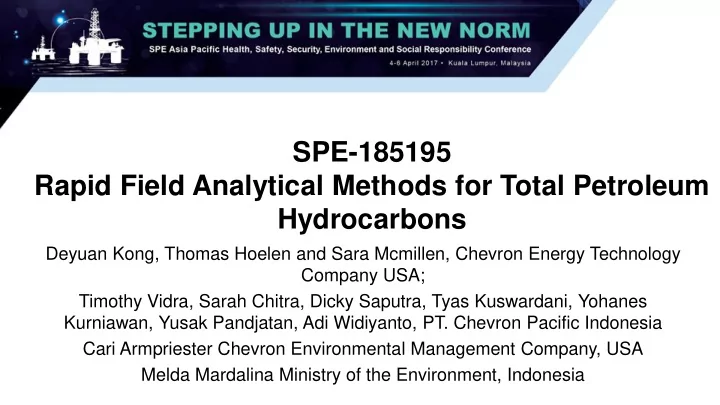

SPE-185195 Rapid Field Analytical Methods for Total Petroleum Hydrocarbons Deyuan Kong, Thomas Hoelen and Sara Mcmillen, Chevron Energy Technology Company USA; Timothy Vidra, Sarah Chitra, Dicky Saputra, Tyas Kuswardani, Yohanes Kurniawan, Yusak Pandjatan, Adi Widiyanto, PT. Chevron Pacific Indonesia Cari Armpriester Chevron Environmental Management Company, USA Melda Mardalina Ministry of the Environment, Indonesia
Slide 2 Project Background Opportunity Soil samples from hydrocarbon impacted soil in CPI operations need to be tested for Total Petroleum Hydrocarbon (TPH) – Delays in sample analyses and decision making due to thousands of soil samples per week needing analysis – Lab analysis can take 2-4 weeks Approach Development of rapid TPH analytical method to increase accuracy and efficiency 1) real-time remediation process monitoring 2) reducing the number of samples going to lab SPE- 185195 • Rapid Field Analytical Methods for Total Petroleum Hydrocarbons • Deyuan Kong
Slide 3 Six FTKs have been Selected and tested with field soil samples Extraction Method Extraction Data Quality Solvent semi-quantitative FTK-1 Turbidity Yes Methanol screening FTK-2 Infrared Yes Hexane quantitative Ultraviolet semi-quantitative FTK-3 Yes Methanol fluorescence screening semi-quantitative FTK-4 Colorimetry Yes Dichloromethane screening FTK-5 Visual Yes Heptane qualitative screening FTK-6 Visual No Water qualitative screening SPE- 185195 • Rapid Field Analytical Methods for Total Petroleum Hydrocarbons • Deyuan Kong
Slide 4 FTKs Performance Evaluation Results FTK-1 versus GC FTK-2 versus GC 10 100 TPH (%) by FTK-1 TPH (%) by FTK-2 10 1 1 0.1 0.1 0.01 0.01 0.01 0.1 1 10 100 0.01 0.1 1 10 100 TPH (%) by GC-FID TPH (%) by GC-FID FTK-1 and FTK-2 demonstrated the good correlation with referenced lab GC data SPE- 185195 • Rapid Field Analytical Methods for Total Petroleum Hydrocarbons • Deyuan Kong
Slide 5 Six FTKs have been Selected and tested with field soil samples FTK-3 versus GC FTK-4 versus GC 10 1000000 TPH (ppm) by FTK-3 TPH (%) by FTK-4 100000 1 10000 1000 0.1 100 10 0.01 1 0.01 0.1 1 10 100 0.01 0.1 1 10 100 TPH (%) by GC-FID TPH (%) by GC-FID FTK-3 and 4 might be able to use in field settings after proper calibration FTK-6 showed non-detect for all samples due to matrix effects SPE- 185195 • Rapid Field Analytical Methods for Total Petroleum Hydrocarbons • Deyuan Kong
Slide 6 Handheld IR Instrument for non-destructive TPH measurement • Portable handheld IR instrument • Diffuse reflectance of IR light reflected from the sample • The world’s first handheld instrument for the direct measurement of TPH in soil • User simply pulls the trigger for a 15 second reading of TPH (C 10 -C 36 ) in mg/kg IR light is emitted Interacts with the surface of the sample Light is diffusely reflected back to detector IR spectrum (readout) is produced SPE- 185195 • Rapid Field Analytical Methods for Total Petroleum Hydrocarbons • Deyuan Kong
Slide 7 Field Pilot Approach Load the Potential Collect field Calibration Model Field Soil Samples on to Instrument Deployment Process IR analysis samples Predict TPH (split) values and Build Model Using validation tests Partial Least completed with Square Method blind samples Reference Lab GC-FID SPE- 185195 • Rapid Field Analytical Methods for Total Petroleum Hydrocarbons • Deyuan Kong
Slide 8 Pilot Studies Results Evaluation- Minas Field Handheld IR Instrument vs Laboratory TPH Calibration model completed with 111 (C 10 - C 36 ) Concentrations soil samples from Minas field at TPH 20,000 Handheld IR Instrument Predicted TPH range 0-120,000 mg/kg 15,000 Concentration (mg/kg) Using Minas calibration model vs. GCFID Data for validation Test Validation Samples ( • )& Calibration Samples ( ) 10,000 Outliner analysis- spectrum suggests 5,000 the high clay contents of those samples Detection limit of this model- 170 mg/kg 0 0 5,000 10,000 15,000 20,000 Laboratory TPH Concentration (mg/kg) SPE- 185195 • Rapid Field Analytical Methods for Total Petroleum Hydrocarbons • Deyuan Kong
Slide 9 Pilots Studies Results Evaluation- Duri Field Handheld IR instrument vs Laboratory TPH (C 10 - C 36 ) Concentrations 60,000 Handheld IR Instrument Predicted TPH Calibration model completed with 200 soil samples from Duri field at TPH 50,000 Concentration (mg/kg) range 0-50,000 mg/kg 40,000 Using Duri calibration model vs. GCFID 30,000 Data for validation Test Validation Samples ( • )& Calibration Samples ( ) 20,000 Detection limit of this model- 380 mg/kg 10,000 0 0 10,000 20,000 30,000 40,000 50,000 60,000 Laboratory TPH Concentration (mg/kg) SPE- 185195 • Rapid Field Analytical Methods for Total Petroleum Hydrocarbons • Deyuan Kong
Slide 10 Accuracy for various assay ranges for calibration samples for Duri field vs. Minas field Minas (wide range of calibration range up to Duri site (limited calibration range up to 5%) 12%) Assay Range RMSECV Relative Standard Assay Ranges RMSECV Correlation Deviation * (mg/kg (mg/kg TPH) mg/kg Coefficients (r 2 ) (mg/kg TPH) TPH) (%) TPH 0 - 5,000 376 n/a 0 - 3,000 170 0.92 5,000 – 15,000 930 ≤ 19 3,000 - 5,000 184 0.96 15,000 – 20,000 1,390 ≤ 9 5,000 - 15,000 410 0.98 20,000 – 30,000 2,107 ≤ 11 15,000 - 30,000 803 0.99 30,000 – 50,000 2,815 ≤ 9 30,000 - 120,000 2,375 0.99 RMSECV: Root-mean-square Error of Cross-Validation SPE- 185195 • Rapid Field Analytical Methods for Total Petroleum Hydrocarbons • Deyuan Kong
Slide 11 Summary ❖ Portable handheld IR Instrument will enable rapid and accurate delineation of CPI sites & allows real time process monitoring for different remediation technologies • Significant time reductions – Real-time process monitoring – Rapid, field based testing – Improve data density for site assessment – Less waiting time for soil movement • Improved Safety – Prevents worker exposure and generation of waste by eliminating the use of solvents (used in the lab and in other field test methods) SPE- 185195 • Rapid Field Analytical Methods for Total Petroleum Hydrocarbons • Deyuan Kong
Slide 12 Acknowledgements The authors gratefully acknowledge the support and discussion from Ziltek Pty. Ltd and ALS lab in Bogor, Indonesia for deployment of Handheld IR Instrument
Recommend
More recommend